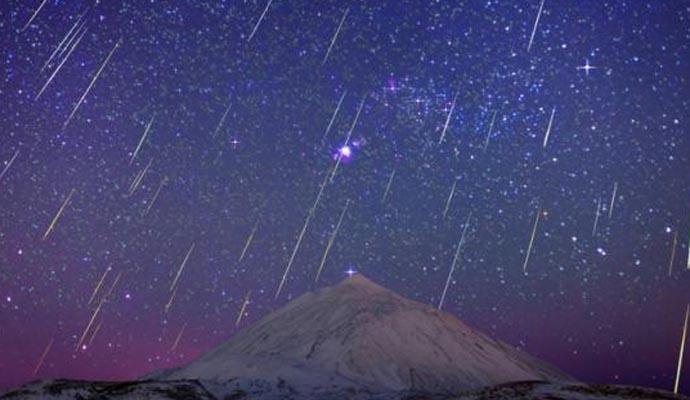Geminids Meteor Shower 2016 that will provoke the asteroid Phaeton in the next days and will have the maximum activity during the dawn of the 14 December 2016, will be emitted live from the skies of the Canary Islands through the European project STARS4ALL and the channel sky-live.tv.
The Canary Islands Astrophysics Institute (IAC) has published a statement on Monday 12 December 2016 explaining that the maximum activity of the Geminids is expected for 00.05, Canary Islands local time on December 14, 2016, and remembers that, next to The Perseids, is one of the great annual spectacles of rain of stars.
The activity of the Geminids last year brushed the 200 meteors per hour.
To observe the rain of stars caused by the strange asteroid Phaeton, which in the future could become a total destroyer of the Earth, as IAC comments, you have to look at Castor and Pollux, the two brightest stars of the constellation Gemini .
At a glance, without the need for any instrument, and with “high doses” of patience, the bright meteors are observed, it is pointed out in the communiqué, which reminds that the skies must be clean, free of artificial light pollution And with clear horizons.
According to the IAC, it is advisable to look at an area of the sky and maintain it for at least a few minutes and you will see that “it rains stars”, and is recommended to lie on the floor, well supplied with warm clothing.
The IAC rates Featon as a tiny celestial body, presumed progenitor of the Geminids since 1983, which “brought and brought astronomers to the head.
The team led by Dave Jewitt of the University of California at Los Angeles (UCLA), aided by NASA’s STEREO probes realized in 2010 that Phaeton experienced an increase in intensity in its brightness.
It was something new that they called “rocky comet”, and the question arose as to whether it is a hybrid between asteroid and comet, and, adds the IAC.
In summary, the IAC explains, is a curious asteroid that approaches the Sun so much – it does it every 1.4 years, in a similar way as a comet would do – that the heat emitted by our star burns the dust residues that cover The rocky surface and thus forms a kind of “gravel tail” in the perihelion, minimum distance to the Sun, says Jewitt, who will participate in the direct from the Canary Islands.
Phaeton is extremely hot, about 700 degrees Celsius, so ice can not survive on its surface.
The statement indicates that as it is so hot the most likely process is a thermal break and also it may have losses through a process called desiccation, because it is heated as compared to other bodies of the solar system when approaching the sun, which is Believes that extreme temperatures are involved in the destruction of parts of the surface whenever it approaches the perihelion.
Javier Licandro, an IAC researcher, points out that at four or five kilometers in diameter Phaeton is a “total destroyer,” and if he collided with the Earth it would produce a catastrophe at the global level that would kill species, “probably including ours.”
Even so, Phaeton is a minor risk on the list of potentially dangerous bodies, says Javier Licandro.
The full Moon of December 14 will coincide with the maximum activity moment of the Geminids and will cause us to lose the weakest meteors due to the increase in ambient light, says the IAC researcher.
In addition to the ground observation, a joint experiment with the Institute of Astrophysics of Andalusia (IAA) will be carried out in the European project ORISON and in an attempt to beat the record of detection in a double station of a car (Canarias – Peninsula).
A stratospheric balloon will be launched from Extremadura to record the rain without the interference of the atmosphere and the Moon.
Due to the high altitude of the phenomenon (about 80 kilometers) and the transparency of the sky of the stratosphere, it is possible that it is possible to observe a car simultaneously from both places.
Extremadura has been chosen for the launch from the Peninsula due to its optimal layout and its clear skies of light pollution.
Courtesy of La Opinion



